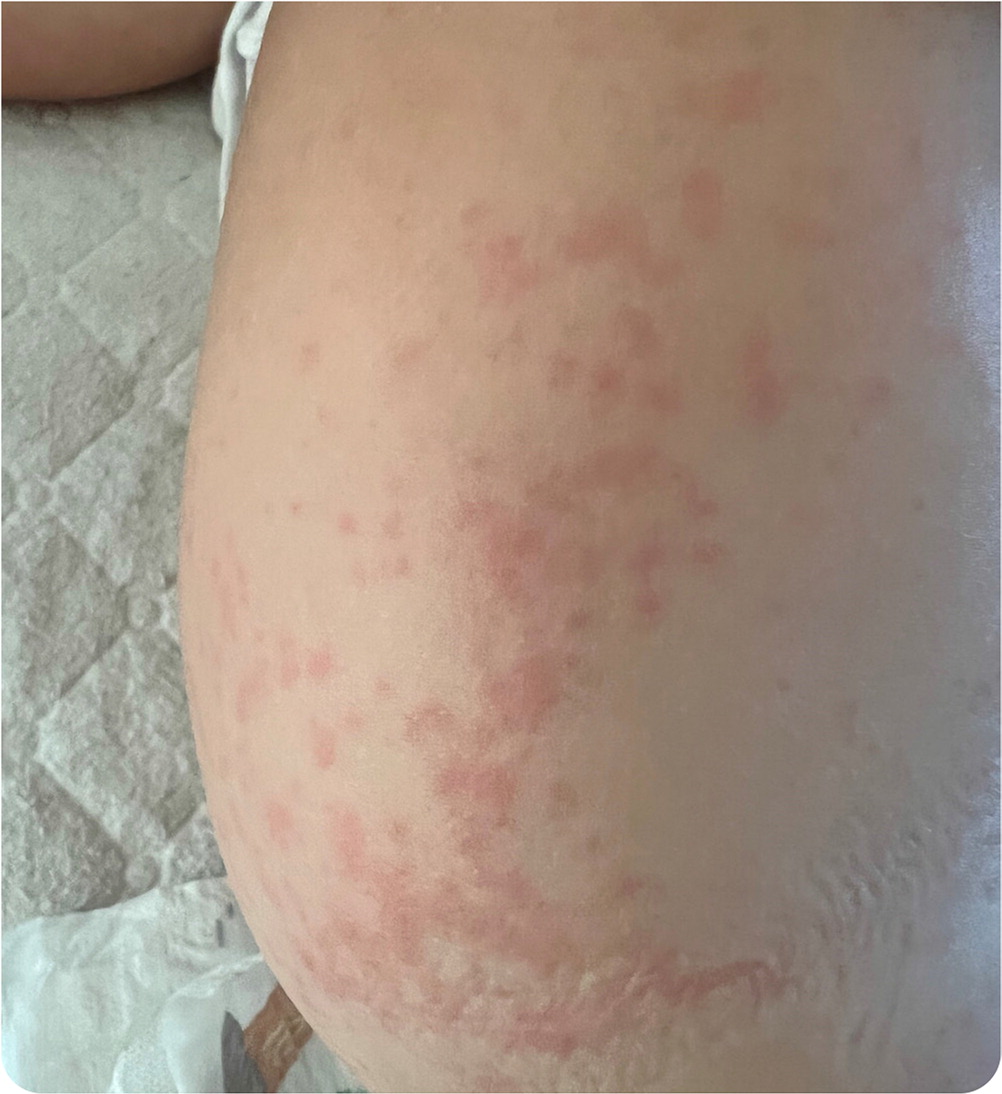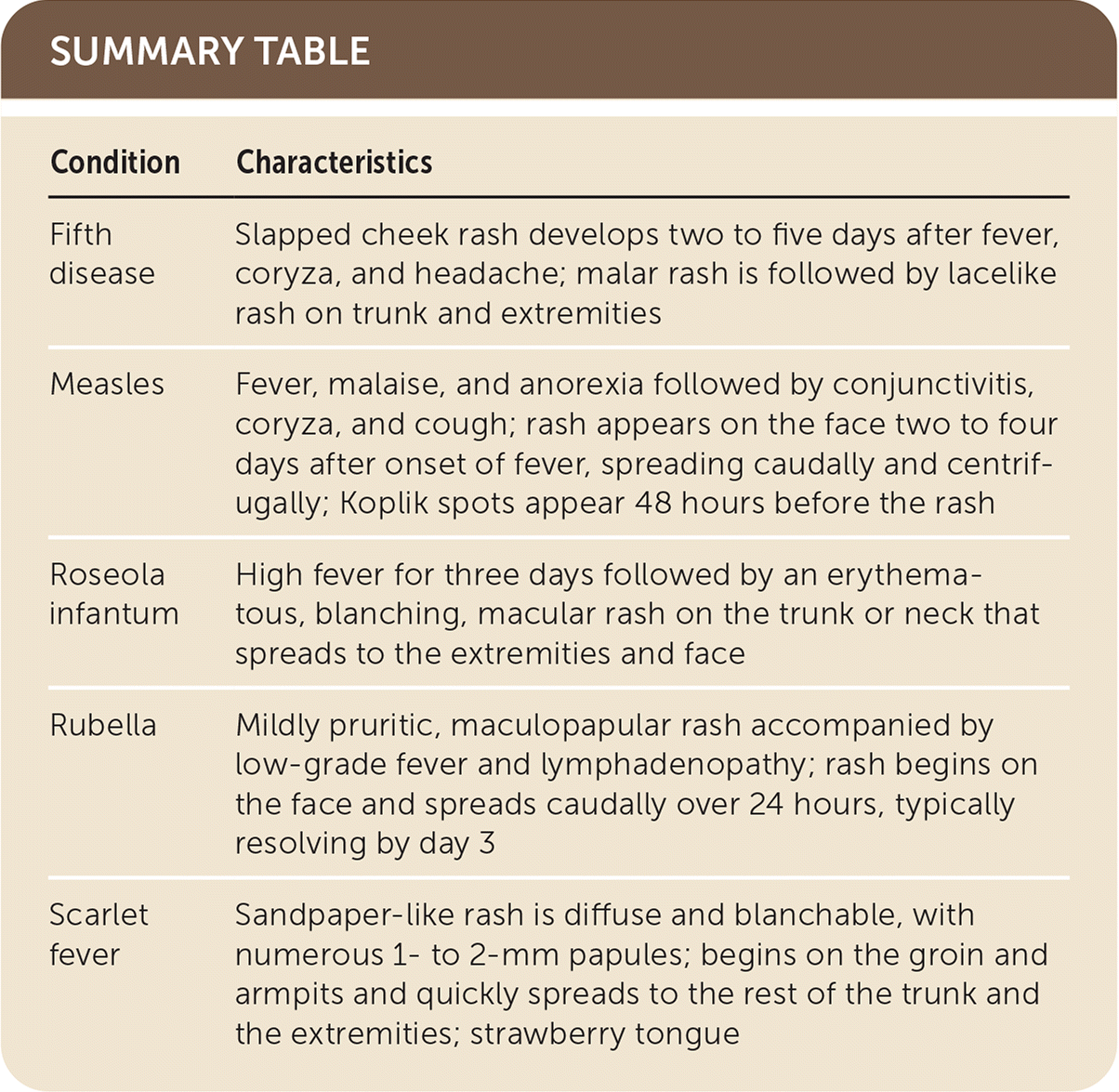
Am Fam Physician. 2023;107(6):649-650
Author disclosure: No relevant financial relationships.
A 23-month-old child presented with fever and lethargy. Two days earlier, her parents noticed she was warm on waking, and her temperature was recorded as 101.6°F (38.7°C). She was given acetaminophen and ibuprofen and slept more than usual that day. Her evening temperature was 103.7°F (39.8°C). The patient had been exposed to a child with streptococcal throat infection at day care earlier in the week.
At the time of presentation the patient was drinking well but pickier than usual with food. She had no significant medical history and was current on immunizations, including those for COVID-19. She was irritable, but there were no abnormal findings on physical examination. Laboratory testing was negative for COVID-19, influenza, and group A streptococci. Over the next few days, her activity level returned to normal; however, low-grade fevers between 100.4°F and 101.3°F (38°C and 38.5°C) persisted.


Question
Based on the patient's history and physical examination findings, which one of the following is the most likely diagnosis?
A. Fifth disease (erythema infectiosum).
B. Measles.
C. Roseolainfantum.
D. Rubella.
E. Scarlet fever.
Discussion
The answer is C: roseola infantum. This viral exanthem of childhood is characterized by three days of high fever that can exceed 104°F (40°C), which may lead to febrile seizures. The fever or seizures are a common reason for presentation to the emergency department but rarely necessitate admission. After several days, the fever abruptly subsides, and the characteristic rash appears. The rash is classically erythematous, blanching, and macular. It starts on the trunk or neck and spreads to the extremities and face. It is asymptomatic and not associated with pruritus, pain, bleeding, or ulceration. The rash resolves spontaneously 10 to 14 days after the initial fever.1
Roseola infantum is most prevalent in children seven to 13 months of age, and most cases occur in children younger than two years. Overall, the most common cause of roseola is human herpes-virus 6B. Less common causes include human herpesvirus 7, enterovirus, coxsackievirus, adenovirus, and parainfluenza virus. Roseola infantum has a seasonal distribution, occurring most often in late summer to early fall. It affects males and females equally. The most common mode of transmission is shedding of the virus from asymptomatic carriers, such as older siblings or parents.
Fifth disease, or erythema infectiosum, is caused by human parvovirus B19. The illness begins with fever, coryza, headache, nausea, and diarrhea followed by a rash two to five days later. The classic slapped cheek rash is erythematous with circumoral pallor, with a lacelike rash developing on the trunk and extremities several days later. The rash may recur after stimuli such as change in temperature, sunlight exposure, stress, or exercise.2
Measles begins with fever, malaise, and anorexia followed by conjunctivitis, coryza, and cough. Characteristic Koplik spots (1- to 3-mm white, gray, or blue elevations with erythematous bases on the buccal mucosa) appear 48 hours before the exanthem. Two to four days after the onset of fever, an erythematous maculopapular rash begins on the face and spreads caudally to the neck, trunk, and extremities. The lesions are initially blanchable. The rash can include petechiae, and the palms and soles are rarely affected. Two or three days after the rash appears, lymphadenopathy, high fever, respiratory symptoms, and conjunctivitis may occur. After three or four days, the rash darkens to a brown color, begins to fade, then desquamates in more involved areas. The rash typically lasts six or seven days before fading.3,4
Rubella is a viral illness that is usually self-limited in children. The illness is generally mild, with minimal systemic symptoms. The mildly pruritic, maculopapular rash is accompanied by low-grade fever and lymphadenopathy. The fever appears one to five days before the rash develops, or they may occur concurrently. The rash of pinpoint, pink macules begins on the face and spreads caudally to the trunk and extremities, sparing the palms and soles, over a period of about three days. Lymphadenopathy is common in the posterior cervical, auricular, and suboccipital lymph nodes. Mild conjunctivitis and Forchheimer spots (small, red spots on the soft palate) may be present.5,6
Scarlet fever presents as an erythematous rash associated with pharyngitis. It is typically caused by Streptococcus bacteria. The rash is diffuse and blanchable, with numerous 1- to 2-mm papules causing a sandpaper-like texture. The rash usually starts on the groin and armpits and quickly spreads to the rest of the trunk and the extremities, sparing the palms and soles, before it desquamates. It often has a linear petechial appearance in the antecubital fossae and axillary folds, known as Pastia lines.6 Other physical findings may include strawberry tongue and circumoral pallor.

| Condition | Characteristics |
|---|---|
| Fifth disease | Slapped cheek rash develops two to five days after fever, coryza, and headache; malar rash is followed by lacelike rash on trunk and extremities |
| Measles | Fever, malaise, and anorexia followed by conjunctivitis, coryza, and cough; rash appears on the face two to four days after onset of fever, spreading caudally and centrifugally; Koplik spots appear 48 hours before the rash |
| Roseola infantum | High fever for three days followed by an erythematous, blanching, macular rash on the trunk or neck that spreads to the extremities and face |
| Rubella | Mildly pruritic, maculopapular rash accompanied by low-grade fever and lymphadenopathy; rash begins on the face and spreads caudally over 24 hours, typically resolving by day 3 |
| Scarlet fever | Sandpaper-like rash is diffuse and blanchable, with numerous 1- to 2-mm papules; begins on the groin and armpits and quickly spreads to the rest of the trunk and the extremities; strawberry tongue |

